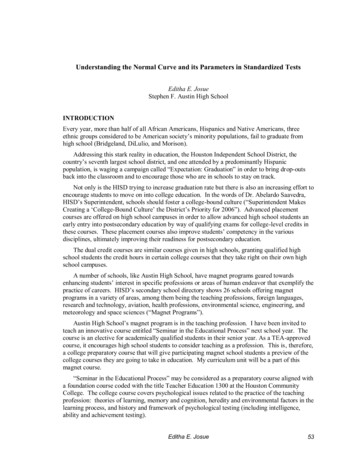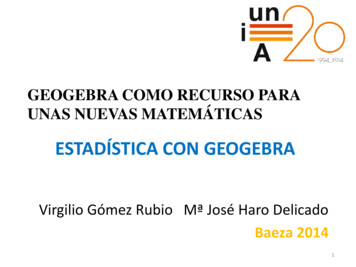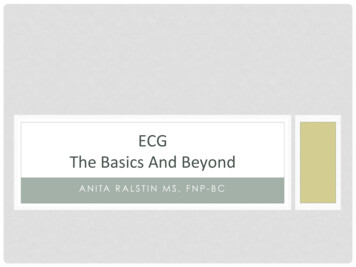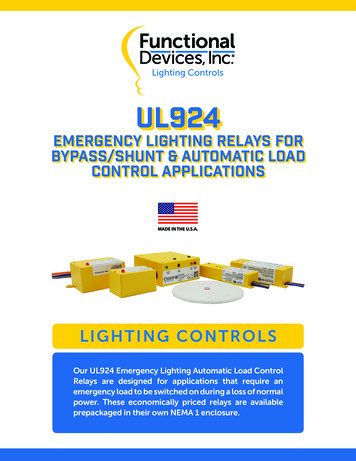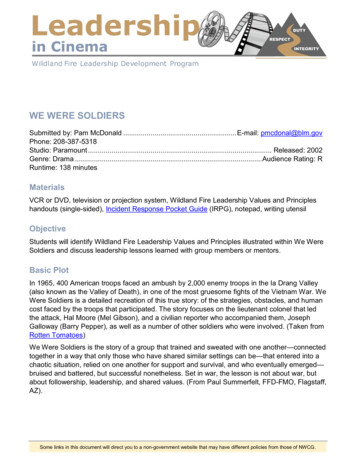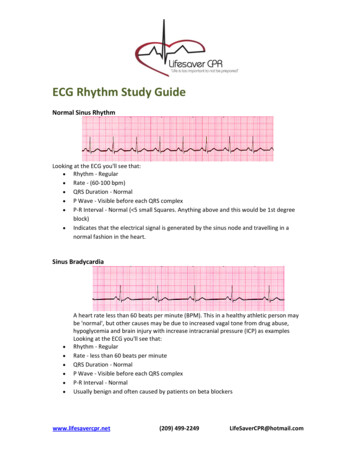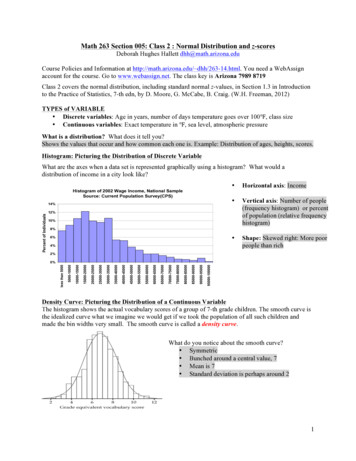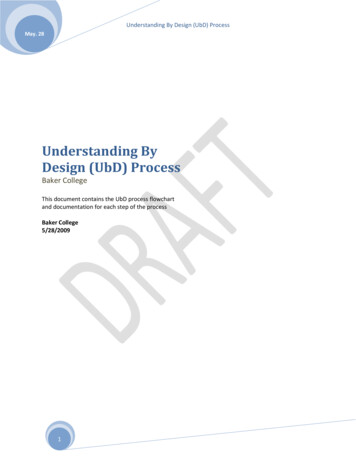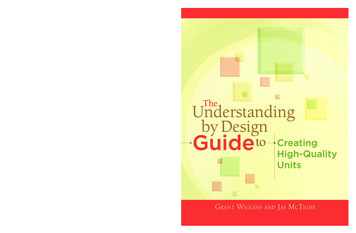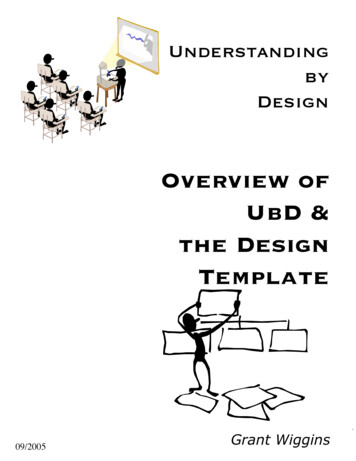
Transcription
UnderstandingbyDesignOverview ofUbD &the DesignTemplate09/2005Grant Wiggins
Understanding by DesignIntroStage 1Stage 2Stage 1 – Desired ResultsStage 3resources templateUbD Template - with questionpromptsEstablished Goal(s):G What relevant goals (e.g., Content Standards, Course or Program Objectives, LearningOutcomes etc.) will this design address?Understanding(s):Students will understand that.U What are the “big ideas”? What specific understandings aboutthem are desired? What misunderstandings arepredictable?Students will know.KEssential Question(sQ What provocative questions willfoster inquiry, understanding, andtransfer of learning?Students will be able to.S What key knowledge and skills will students acquire as a result of this unit? What should they eventually be able to do as a result of such knowledge and skill?Stage 2 – Assessment EvidencePerformance Task(s):T Through what authentic performancetask(s) will students demonstrate thedesired understandings? By what criteria will “performancesof understanding” be judged?Other Evidence:OE Through what other evidence (e.g.quizzes, tests, academic prompts, observations, homework, journals, etc.)will students demonstrate achievement of the desired results? How will students reflect uponand self-assess their learning?Stage 3 – Learning PlanLearning Activities:LW help the students know where the unit is going and what is expected? Help the teacherknow where the students are coming from (prior knowledge, interests)?H hook all students and hold their interest?E equip students, help them experience the key ideas, and explore the issues?R provide opportunities to rethink and revise their understandings and work?E allow students to evaluate their work and its implications?T be tailored (personalized) to the different needs, interests, abilities of learnersO be organized to maximize initial and sustained engagement as well as effective learning? 2003 ASCD and Grant Wiggins & Jay McTighepage 2
Understanding by DesignIntroStage 1Stage 2Stage 3resources template#O.1. Unit Design, Before & AfterPrairie DayA Typical 3rd-Grade Social Studies UnitTopicTopic: Westward Movement and Pioneer Life(social studies - 3rd grade)Activitiesa. Read textbook section - “life on the prairie.” Answer the end-ofchapter questions.b.Read and discuss Sarah Plain and Tall. Complete a “word search”puzzle of pioneer vocabulary terms contained in the story.c. Create a “pioneer life” memory box with artifacts showing whatlife might be like for a child traveling west or living on the prairie.d. PRAIRIE DAY activities: Dress in pioneer clothes and complete seven learning stations:1.churn butter2.play 19th-century game3.send letter home w/ sealing wax4.play “dress the pioneer” computer game5.make a corn husk doll6.quilting7.tin punchingAssessmentsa.b.c.d.e.quiz on pioneer vocabulary terms from Sarah Plain and Tallanswers to end-of-chapter questions on pioneer lifeshow and tell for Memory Box contentscompletion of seven learning stations during Prairie Daystudent reflections on the unitpage 3
Understanding by DesignIntroStage 1Stage 2Stage 3resources templateStage 1 – Desired ResultsEstablished Goal(s): GA SS4H6 The student will explain westward expansion of America Gbetween 1801 and 1861. a. describe territorial expansion with emphasis on the LouisianaPurchase, the Lewis & Clark expedition, and the acquisitions of Texas (the Alamo and independence), Oregon (Oregon Trail), and California (Gold Rush and the development of miningtowns) b. describe the impact of life in America.Understanding(s):“after” backward designStudents will understand that.U Many pioneers had naive ideas about theopportunities and difficulties of movingWest. People move for a variety of reasons -for new economic opportunities, greaterfreedoms or to flee something. Successful pioneers rely on courage,ingenuity, and collaboration to overcomehardships and challenges.Students will know.K key facts about the westward movement and pioneer life on the prairie pioneer vocabulary terms basic geography (i.e., the travel routes of pioneers and location of their settlements)QEssential Question(s Why do people move? Why did the pioneers leave their homes to head west? How do geography and topography affecttravel and settlement? Why did some pioneers survive andprosper while others did not? What is a pioneer? What is “pioneer spirit”? What was pioneer life really like?Students will be able to.S recognize, define, and use pioneervocabulary in context use research skills (with guidance) to findout about life on the wagon train and prairie express their findings orally and in writingStage 2 – Assessment EvidencePerformance Task(s): TCreate a museum display, including artifacts, pictures,and diary entries, depicting “a week in the life” of afamily of settlers living on the prairie. (What commonmisunderstandings do folks today have about prairielife and westward settlement?)Write 1 letter a day (each representing a month oftravel) to a friend “back east” describing your life onthe wagon train and the prairie. Tell about your hopesand dreams, then explain what life on the frontierwas really like. (Students may also draw pictures andexplain orally.)Other Evidence:OE oral and/or written response to one ofthe Essential Questions drawing(s) showing hardships of pioneer life test on facts about westward expansion,life on the prairie, and basic geography explanation of the “memory box” contentsStage 3 – Learning PlanLearning Activities:(selected)L Use K-W-L to assess students’ prior knowledge and identify learning goals for the unit. Revise Prairie Day activities (e.g., substitute Oregon Trail 2 computer simulation for “dress the pioneer”and ask for journal entries while the simulation is played). Include other fictional readings linked to the identified content standards/understandings (e.g., Little Houseon the Prairie, Butter in the Well). Create a “timeline map” of a pioneer family’s journey west. Add non-fiction sources to accommodate various reading levels, such as Life on the Oregon Trail, Diaries ofPioneer Women, and Dakota Dugout. Guide students in researching the period using a variety of resources. Review the scoring rubrics for “memory box,” museum display, letters, and journals before students begin theperformance tasks. Include opportunities for students to study examples of these products. 2003 ASCD and Grant Wiggins & Jay McTighepage 4
Understanding by DesignIntroStage 1Stage 2Stage 3resources template#O.2. Unit Design, Before & After“before” backward design: textbook coverage-orientedA Typical 10th-grade Geometry UnitTopic/objectivesTopic: Surface Area and Volume (HS geometry) know how to calculate surface area and volume for various 3-dimensional figures know and use Cavalieri’s Principle to compare volumes know and use other volume and surface area formulae to compare shapesLessons/Activities Read Chapter 10 in UCSMP Geometry Go through all the formulae and examples Exploration 22, p. 482 – “Containers holding small amounts can be made toappear to hold more than they do by making them long and thin. Give someexamples.”Assessmentsa. odd-numbered problems in full Chapter Review, pp. 516-519b. progress self-test p. 515c. homework: each 3rd question in sub-chapter reviews and completion of theexplorationspage 5
Understanding by DesignIntroEstablished Goal(s):Stage 1Stage 2Stage 3resources templateStage 1 – Desired ResultsGNH Math Standards4a. K-12 Broad Goal: Students will name, describe, model, classify, and compare geometricshapes and their properties with an emphasis on their wide applicability in human activity.1a. K-12 Broad Goal: Students will use problem-solving strategies to investigate and understand increasingly complex mathematical content.Understanding(s):“after” backward designStudents will understand that.UQEssential Question(s How well can pure mathematics model The adaptation of mathematical modelsmessy, real-world situations?and ideas to human problems requires careful judgment and sensitivity to impact. When is the best mathematical answer Mapping three dimensions onto two (ornot the best solution to a problem?two onto three) may introduce distortions. Sometimes the best mathematical answer How do you design the most economicalis not the best solution to “real-world”packaging?problems.Students will know. formulae for calculating surface areaand volume Cavalieri’s PrincipleKStudents will be able to.S calculate surface area and volume forvarious 3-dimensional figures use Cavalieri’s Principle to compare volumesStage 2 – Assessment EvidencePerformance Task(s):T Packaging problem: what is the idealcontainer for shipping bulk quantities ofM & M’s packages cost-effectively tostores? (Note: the “best” mathematicalanswer - a sphere - is not the best solution to this problem.) Consult to the UN on the least controversial 2-dimensional map of the world.Other Evidence:a. odd-numbered problems in fullChapter Review, pp. 516-519OEb. progress self-test p. 515c. homework: each 3rd question insub-chapter reviews and completionof the explorationsStage 3 – Learning PlanLearning Activities:(selected) Investigate the relationship of surfaceareas of various containers and volume(e.g. tuna fish cans, cereal boxes, Pringles, candy packages, etc.). Investigate different map projections todetermine their mathematical accuracy(i.e. degree of distortion). 2003 ASCD and Grant Wiggins & Jay McTighea. Read Chapter 10 in UCSMP Geometryb. Exploration 22, p. 504c. Exploration 22, p. 482d. Exploration 25, p. 509Lpage 6
Understanding by DesignIntroStage 1Stage 2Stage 3resources templateStage 1: Key Design ElementsIn Stage 1, designers consider the following elements. A variety of examples and design tools areprovided to assist. Note: There is no required sequence to the design process – designers can enterat any point. However, all of the design elements should be considered.GTest your ideasagainst the Stage 1Design Standards andrevise as needed.K“Unpack” the GOALS(e.g. content standards)to derive the big ideas,key knowledge/skills.Identifythebig ideas.SIdentify keyKNOWLEDGEand SKILLS.Stage 1Considerpossiblemisunderstandings.UFrame thebig ideas as specificUNDERSTANDINGS (“the student willunderstand THAT.”)QSelect/developESSENTIALQUESTIONS toguide inquiry intothe big ideas.Essential Questions for Stage 1 What should students leave able to do, on their own (transfer)?What understandings about key ideas should they leave with?What do Content Standards imply for learning goals - i.e. what should students know and be ableto do, given the content targeted?What big ideas should anchor and organize the content, framed as Essential Questions? What docommon/predictable misunderstandings suggest what the desired understandings ought to be? 2003 ASCD and Grant Wiggins & Jay McTighepage 7
Understanding by DesignIntroStage 1Stage 2Stage 3resources templateStage 2: Key Design ElementsConsider the following elements as you identify the evidence needed to determine the extent to whichthe desired results (Stage 1) have been achieved. A variety of examples and design tools is providedto assist.Consider evidence ofthe understanding(s),knowledge and skillsidentified in Stage 1.Test your ideasagainst the Stage 2Design Standards andrevise as needed.OEIdentify theOTHER EVIDENCEthat will be neededStage 2Use the 6Facets to identifyneeded evidence ofunderstanding.TRIdentify appropriatecriteria and use them todevelop the scoringRUBRIC(s).Use theG.R.A.S.P.S. elementsto design authenticPERFORMANCETASKS.Essential Questions for Stage 2 What evidence must be collected and assessed, given the Desired Results of Stage 1?What is evidence of understanding (as opposed to recall)?What important transfer tasks should anchor the assessment since transfer is the essence of understanding?What criteria should be used to assess work related to the Desired Results, not just the particularsof the task? 2003 ASCDpage 8
Understanding by DesignIntroStage 1Stage 2Stage 3 resources templateStage 3: Key Design ElementsConsider the following as you develop the learning plan, mindful of the desired results identifiedin Stage 1 and the needed evidence in Stage 2. There are a variety of ways to “teach for understanding,” and UbD is compatible with many instructional frameworks. Regardless of the instructionalapproach and specific teaching techniques, designers are encouraged to consider the W.H.E.R.E.T.O.elements as they plan.Test yourproposed learningplan against WHERETO and for alignmentwith Stages1 & 2. and adjust asneededUse the six facetsto generate newideas for learningConsiderwhat needsto be“uncovered”vs. covered.Stage 3Use diagnosticand formativeassessments tomonitor andadjust.Framethe learningviaquestionsEssential Questions for Stage 3 What can I do to make the work maximally engaging and effective?If the “content” is the answer, then what were the original questions?What content should we cover? What content needs to be “uncovered”?When should the “basics” come first? When should they be on a “need to know” basis?When should I teach, when should I coach, and when should I facilitate student “discovery”?How do I know who and where the learners are?What should I do if they already know/ can do? What should I do if they don’t?In order to truly meet the standard, what should they be able to do independently (transfer)? Whatshould I be doing to make them more independent and able to transfer? 2003 Grant Wiggins & Jay McTighepage 9
Understanding by DesignIntroStage 1Stage 2Stage 3resources templateUbD Curriculum FrameworkA UbD Curriculum FrameworkUnderstanding by Design offers a 3-stage “backward design” framework for developing units ofstudy (micro level). The same process guides larger-scale curriculum development for courses andprograms (macro level). The following visual represents a UbD curriculum structure for building acoherent curriculum, spiraling around “big ideas,” essential questions, and core assessments.Organizational GoalsProgramsCross-disciplinary ideas, habits of mind, competenciesContent StandardsArtsLanguageArtsScience EssentialQuestionsKey CourseTasks & RubricsUnit 3Unit 2UTCourse 10Course 11Course 12Course 7Course 8Course 9Course 4Course 5Course 6CourseUnderstandingsUnitsP. E./ TechnologyWorldEd.HealthLanguagesKeytransfer tasks &rubricsCourse 1Course 2Course 3Unit 1MathematicsUnit 4QOEpage 10Course EssentialQuestionsUnit 5Unit 6
Understanding by DesignIntroStage 1Stage 2Stage 3resources templateDesign Entry Points#G.2.a. Tools: Entry Point – Content StandardsContentStandard(s): What big ideas and transfer goalsare embedded in this standard? Whatare the key “nouns” and “verbs”? Whatshould student eventually be able todo on their own if they meet the Standard? What will studentscome to understandif they really learnthis content well?Stage 1 – Desired ResultsQUStage 2 – Assessment Evidence What specific“real-world” transfer tasks should astudent be able todo well if they havemet this standard?TOEStage 3 – Learning Plan What importantquestions are raisedby this content? What essentialquestions will guideinquiry into it? What evidenceof learning is stated or implied inthe standard (andits indicators)? What morediscrete tests dothey suggest?L What learning experiences will help“uncover” the big ideas in the standard? What instruction is needed to equipstudents to meet this standard? 2002 ASCD and Grant Wiggins & Jay McTighepage 11
Understanding by DesignIntroStage 1Stage 2Stage 3resources template#G.2.b. Entry Point – Important Topic/ContentTopic/Content: What content standard(s) justify orrelate to this topic? What should students be able to dowith the content, if they understand? What is the “bigidea” (the “moralof the story”) thatwe want studentsto understandabout this topic? What kinds of“real-world”performancestest understandingof this content?Stage 1 – Desired ResultsUGQStage 2 – Assessment EvidenceTOEStage 3 – Learning Plan What importantquestions areraised bythis topic? What questions willguide inquiry intothe important ideas? What evidencewill show thatstudents havelearned thiscontent?L What activities and instruction willengage students and help them better grasp the essence and the value ofthis topic/content? 2002 ASCD and Grant Wiggins & Jay McTighepage 12
Understanding by DesignIntroStage 1Stage 2Stage 3resources template#G.2.c. Entry Point – Important Skill/ProcessSkill/Process: What content standard(s) call for, orimply, mastery of this skill/process? What is the purpose or value of thisskill/process? What important transferability does the skill help make possible? What understanding(s) will enablestudents to use theskill wisely? What are thestrategic understandings neededfor effective use? What complex,“real-world”performances doesthis skill enable?Stage 1 – Desired ResultsUGQStage 2 – Assessment EvidenceTOE What importantquestions are raisedwhen attempting touse/improve this skill? What essentialquestions will guidethoughtful use? What evidence willshow that studentshave mastered thisskill/process?Stage 3 – Learning PlanL What instruction and learning activities will mosteffectively help to develop, refine, and make automaticthis skill/process? What kinds of complex and interesting challenges canmake the skill’s value more apparent and meaningful? 2002 ASCD and Grant Wiggins & Jay McTighepage 13
Understanding by DesignIntroStage 1Stage 2Stage 3resources templateThe Big Ideas of Understanding by Design1. UbD is a way of thinking purposefully about curricular planning and school reform, a set of helpful design tools, anddesign standards -- not a program or recipe.2. The end goal of UbD is understanding and the ability totransfer learnings – to appropriately connect, make sense of,and use discrete knowledge and skills in context.3. Evidence of understanding is revealed through performance– when learners transfer knowledge and skills effectively, using one or more “facets” (explain, interpret, apply, shift perspective, empathize, and self-assess).4. Educators are coaches of understanding, not mere purveyorsof content or activity.5. Planning is best done ”backward” from the desired resultsand the transfer tasks that embody the goals.6. UbD transforms Content Standards and other goals into focused learning targets based on “big ideas” and transfertasks.7. Design Standards guide self-assessment and peer reviews ofcurriculum, instruction, and assessment for quality control.8. UbD reflects a “continuous improvement” approach to design and learning. The results of our curriculum designs(e.g., assessment results, quality of student work, degree oflearner engagement) inform needed adjustments. Grant Wiggins, Denise Wilbur & Jay McTighepage 14
Understanding by Design Intro Stage 1 Stage 2 Stage 3 resourcestemplate ASCD 2003 page 8 Stage 2: Key Design Elements T R Stage 2 Consider the following elements as you identify the evidence needed to determine the extent to which variety of examples and design tools is provided A the

